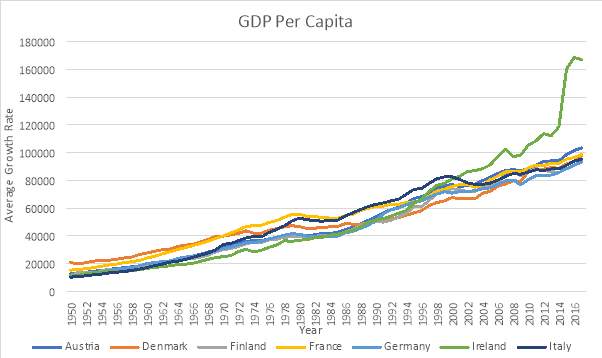Advantages and Disadvantages of Penn World Tables
Donald Trump’s Escalation of US Trade War Over the World
August 23, 2022Macroeconomic Analysis of China and India
August 23, 2022Advantages and Disadvantages of Penn World Tables
Graphs Generated from Penn World Tables:

(Data above was compiled using the Penn World Table online access tool.)

(Data above was compiled using the Penn World Table online access tool.)
Section A
Introduction:
In economic studies based on the Solow growth model we frequently come across the term ‘convergence.’ Barro and Salla-i-Martin says if several different economies who have the same preferences and technology, given to the existence of diminishing marginal returns in the use of accumulating factors, such as capital would grow at its own steady-state however, at the same time, difference in income per capita income would tend to diminish. (Sala-i-Martin, 1995.)
This theory predicts an ongoing process of catching up, also known as conditional convergence or ‘sigma-convergence.’ The second definition of convergence is when rich and poor countries reach the same steady state of income level, meaning absolute convergence, i.e. ‘beta-convergence.’ (Sala-i-Martin, 1996)
Section B
Penn World Tables:
William Baumol study conducted in 1986 empirically analyses the convergence hypothesis against 16 different ‘industrialised’ countries. He argued convergence has shown strong GDP of industrial nations since 1870. Baumol regressed real GDP per capita over that period over a constant and the initial output per capita in 1870. (Baumol, 1986)
In this report we investigate growth rate between seven out of the original twenty countriesfrom theorganisation foreconomic co-operation development (OECD). Six were part of Baumol’s original 16 counties in his research. these six countries are Austria Denmark Finland France Germany and Italy while Ireland is the seventh country. We normally expect these western developed countries to have similar institutions and grow at a moderately steady state, but this is not the case. From the graph on page 2 convergence has occurred. this iswhere the poorer developed countries fromthestartof1950caught up withthepreviously advancedcountries such Austria, France and Denmark, while places like Italy were relatively close to Irelands GDP in 1950. Italy and Ireland will not cross paths again until 2001 when Ireland surpasses Italy in growth and continues to do so towards 2016. It can be said that ‘conditional convergence’ has taken place over these seven economies. This is due to these economies experiencing beta convergence but are conditional on other variables such as the population and investment rate are held constant. In this case, these variables are not being held constant. Thus, resulting in the Irish economies GDP to soar.
Section C
Advantages:
Many arguments arise after researchers suggest that countries who have low earning wages may have a future advantage in terms of worker productivity and economic growth. (Taylor, 2014) The first argument is focused on the law of diminishing marginal returns, meaning that as an economy invests and profits from their initial investment, its value will decrease as time goes by and beco

